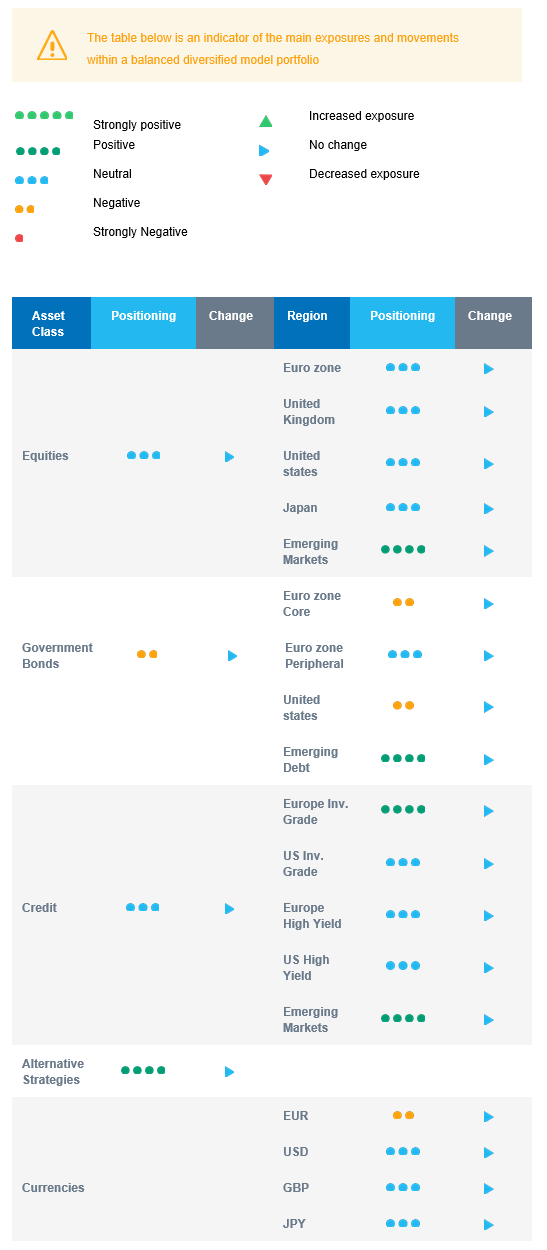Last week in a nutshell
- Last Friday marked the first anniversary of the invasion of Ukraine by Russia.
- Global flash PMIs beat estimates, while disinflation seems very gradual at the start of the year.
- In Europe, various business and consumer sentiment surveys improved as the energy crisis eases, and the labour market stays strong.
- Overall, the combination of more robust growth and a very gradual disinflation led markets to reprice central bank terminal rates higher.
What’s next?
- Along with the monthly job report, markets will continue to digest stronger than initially reported inflation data and watch for US consumer confidence indicators.
- The euro zone will release preliminary data on inflation for the month of February. The ECB has raised its main rates by 300 bp since last July and quantitative tightening is expected to start in March.
- Global PMIs for key countries will be published, with China in the spotlight as investors will gauge the pace of post-reopening, post New Year recovery and its ripple effect on the global economy.
- In Japan, the BoJ governor and deputy governor candidates will appear for hearings while core consumer inflation hit a fresh 41-year high.
Investment convictions
Core scenario
- Our current economic scenario is based on a soft landing of the US economy in 2023. We expect a consolidation phase on financial markets in the short-term after a strong start to the year.
- Credit is a strong conviction for the start of 2023 since the carry that was reconstituted by the rise in yields in 2022 looks attractive. We are overweight Credit, including Emerging market debt.
- We see equity markets moving within a broad range: limited to the upside by the actions of central banks, which will ensure that financial conditions do not ease too quickly if the economy is holding up well and supported by a faster monetary policy pivot if the economy is too hard hit.
- We expect emerging market to outperform as valuation has become more attractive while Asia keeps superior long-term growth prospects vs. developed markets, given that China’s re-opening is rather quick.
- Warm weather has shielded the euro zone growth and decreased the odds of being severely hit by the natural gas crisis. The labour market and consumption are holding up. Inflationary pressures lessened somewhat. With the re-opening of China, Europe should likely resume its export growth.
- In this environment, we expect Alternative investments to perform well.
Risks
- We maintain our view that the bounce observed since October, and which continued unabated since the start of the year has reached an unusual, extreme steepness earlier this month. A pause in the steep returns registered since the start of the year appears appropriate going forward.
- Overall, inflation declines and a rise in growth at some point in 2023 is limiting the market downside. But we know that the central banks anti-inflation stance is also capping the upside potential for risky assets. We note a more hawkish tone in February which has pushed yields higher.
- As central banks become more data dependent, and, for the time being, the economy is surprising on the upside, markets might price in a more restrictive Federal Reserve than currently anticipated.
- Among the upside risks, the Chinese re-opening is good news for the domestic and global growth as long as there is no global inflation spill over via a resurgence of commodity prices in the context of constrained supply.
Cross asset strategy
- Our multi-asset strategy is currently neutral as signs are pointing towards a consolidation. With a less attractive risk/reward on the US equity market, we keep a neutral stance on equities.
- We are neutral equities vs bonds. We have convictions in specific assets.
- Within regional equity preferences, we believe in the Emerging markets region, as valuation is relatively attractive and there is room for a catch-up vs. developed markets.
- In the current environment, we prefer defensive sectors, such as Healthcare and Consumer Staples while a pause in the Tech sector appears warranted.
- The Health Care sector is expected to provide some stability: no negative impact from the war in Ukraine, defensive qualities, low economic dependence, innovation, and attractive valuations.
- In addition, the current context continues to favour companies with pricing power, which we find in the Consumer Staples segment.
- In bonds, most asset classes have an attractive carry. European investment grade credit is one of our strongest convictions. We also have exposure to emerging debt and to global high yield debt.
- We have a slight short duration positioning, mainly via core Europe.
- We have exposure to some commodities, including gold and commodity-related currencies, including the Canadian dollar.
- In our long-term thematics and trends allocation: We favour investment themes linked to the energy transition and keep Technology in our long-term convictions. We expect Automation and Robotisation to recover in 2023, and a growing interest in Climate and Circular Economy-linked sectors (such as Industrials and Technology).
Our Positioning
Our current positioning is neutral equities, with a preference for Emerging markets. On the fixed income side, we have a constructive view on Investment Grade Credit. We keep a slight short portfolio duration via EU sovereign bonds and took profit on our tactical short US duration. In the context of robust growth and the reopening in China, we remain allocated to some commodities.

